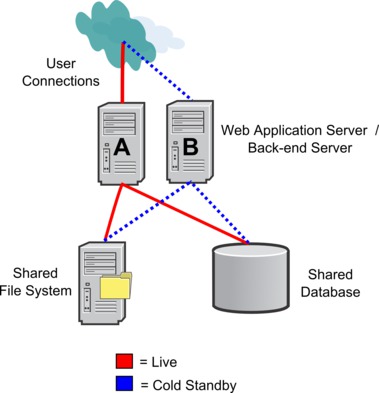The Campaign web application server components do not support a load balanced web application environment. However, environments can be configured with standby servers to address web application server failures. The process for switching to a standby web application server for
Campaign is described below.
In Campaign, certain objects, such as offers, are cached in the web application server to improve response times in the user interface. In a load balanced environment, offers created on one web application server might not be immediately available to users whose sessions connect through another server. To avoid this problem,
Campaign does not support a load balanced configuration.
A configuration with a standby server can be used to minimize disruptions in application availability in the event of a web application server failure. Because the Campaign system tables are stored in an external database, it is not necessary to replicate data to the standby server. If the primary web application server fails, the
Campaign web application must be started on the standby server. When started, the
Campaign web application will retrieve all current data from the
Campaign system table database.
The recommended configuration consists of two separate Campaign servers, one "hot," and one "cold." A "hot" server is the one being used, while the "cold" server is the server on standby. Allowing multiple web application servers to access a single back-end server is not recommended because it can affect performance. If you assume that there is a one to one relationship between web application servers and back-end servers (for performance reasons), then putting the servers on separate machines introduces more points of failure. The benefit of having one dedicated server for the web application and one for the back-end server is that both can be tuned appropriately. If the web application server is also used to serve other web applications, consider using a separate back-end server to avoid a performance impact on the web application server by the back-end server. This determination needs to be made on a case by case basis and is often part of the implementation planning.
There are several non-IBM® Campaign dependencies inherent in this configuration:
